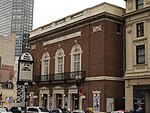Plymouth Theatre (Boston)
The Plymouth Theatre (1911–1957) of Boston, Massachusetts, was located on Stuart Street in today's Boston Theater District. Architect Clarence Blackall designed the building for Liebler & Co. Performers included Henry Jewett, Bill "Bojangles" Robinson, 8-year-old Sammy Davis, Jr., and Bette Davis. In October 1911, the touring Abbey Theatre presented Synge's Playboy of the Western World at the Plymouth; in the audience were W. B. Yeats, Isabella Stewart Gardner and Rose Fitzgerald Kennedy."The Shubert Organization of New York bought the Plymouth in 1927 and used it largely for tryouts of plays headed for New York or going on tour, and for some long run performances." In 1957 the building became the Gary Theater.
Excerpt from the Wikipedia article Plymouth Theatre (Boston) (License: CC BY-SA 3.0, Authors).Plymouth Theatre (Boston)
Park Plaza, Boston
Geographical coordinates (GPS) Address Nearby Places Show on map
Geographical coordinates (GPS)
| Latitude | Longitude |
|---|---|
| N 42.351169444444 ° | E -71.065963888889 ° |
Address
Massachusetts State Transportation Building
Park Plaza
02108 Boston
Massachusetts, United States
Open on Google Maps







